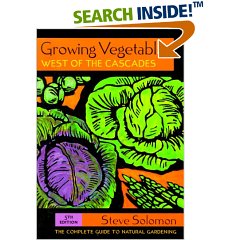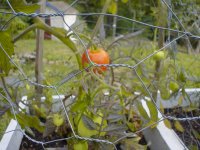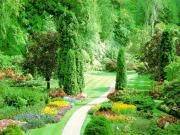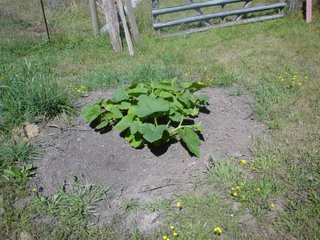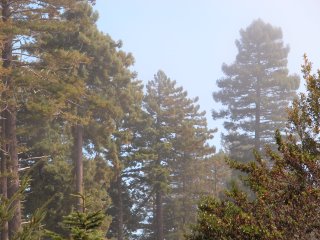
I've been busy traveling and getting my daughter ready for school, so I haven't had time to post a thing lately. I did have to write an article for my magazine writing class. I chose to write about gardening with native plants. Here's the article:
GARDENING WITH NATIVE PLANTS
Have you driven down the highway in spring and admired the golden hues of the blooms of the scotch broom? Have you admired the beautiful green leaves of ivy growing up the wall of the quaint craftsman down the street? You may even have found these plants at your local nursery and considered planting them in your own yard. But should you?
“Why not?” you may ask. “They’re growing in the wild and sold in the local nursery, so they must be a native plant, and therefore a good thing to plant in my yard.”
It’s true that you may see these plants everywhere along the roadsides and in your nursery, but that does not necessarily make them native. In fact, about three percent of the plant species in California are considered invasive. Three percent may not sound like much, but they inhabit far more area.
A non profit group called the California Invasive Plant Council or Cal - IPC has defined invasive plants as plants that have “evolved in one region of the globe are moved by humans to another region, a few of them flourish, crowding out native vegetation and the wildlife that feeds on it.” These plants affect the soil chemistry, increase the danger of wildfire and flooding and use more water than native plants.
So, what should you take into consideration when considering landscaping with native plants in your garden? Are you concerned about water conservation? Do you have erosion problems? How healthy is your soil? Do you want to limit the use of pesticides and other toxins? Do you want to attract local wildlife, birds, butterflies and other beneficial insects?
These are all things that can be improved, or diminished depending on your plant choices.
To help me in understanding how to make wise plant choices for a healthy native garden I spoke with Susan Taylor. Susan is a local biologist who received her BA degree in biology from Hollins University. She is currently the associate environmental planner for Cal-Trans in Humboldt County. Susan acts as project manager for revegetation projects in which habitat and vegetation are removed for highway projects. She identifies invasive plant species and develops and implements eradication projects for transportation projects. She is also an avid gardener and incorporates native plants in her own garden.
The first thing Susan was adamant about was to never plant an invasive species in your landscape. You will be asking for trouble down the line. They spread so prolifically that they take away from the food supply of the other plants in your garden. They will eventually choke your other plants out. English and German ivy are prime examples of this. When this happens your plant diversity diminishes, which will cause your garden to be more susceptible to pests and disease. A more diverse garden will attract more beneficial insects to your garden, and not compromise the health of the soil. Avoiding invasive plants and planting more native plants will help to maintain a healthy balance in your garden.
Susan also pointed out that “local” is a relative term. Many plants in California can become naturalized to an area that it is not native to. A good example of this is California’s state flower, the California poppy. This flower is “local” to southern California, but it is not native to the northern end of the state. Most people think of this flower as being native to the entire state. Many people also confuse the difference between invasive plants and weeds. Many plants that are considered weeds, like dandelions, are native, and not considered invasive, unless, of course, you are avid about a perfect lawn. Plants that are native to an area, would find it difficult to become invasive in their local habitat because of natural checks and balances within the ecosystem that keep them under control.
Going back to the things to consider when planning your native garden, there are certain advantages, according to Susan, that native plants will have over others. Native plants use less water than non natives or invasive plants. Many native plants aid in erosion control, which is a major issue in northern California. Native plants will reduce the need for pesticides making your garden less toxic, and reducing the cost of gardening. One of the most enjoyable benefits of native plants is that they attract beneficial insects, and many beautiful butterflies, local birds, and other wildlife. The only downside, is that a native plant garden can be slow growing. You won’t have an instant garden, but it is well worth the wait.
In xeriscaping Susan said there are really no native plants she would caution people from using, but if you have a pristine lawn you may want to avoid some plants. Any plant that spreads through rhizomes, like the wood sorrel, or bleeding hearts, can quickly take over a perfect lawn.
So, is it ok to plant non native plants at all? “Yes” says Susan. “Gardening is a personal thing.” she says. “Certain plants hold meaning for people, and gardening can be a very spiritual hobby. If a plant is special to you, by all means plant it”, but, as Susan says, “ be responsible, do your research first.” Make sure it is not considered invasive so that you won’t have problems and have to go through the hassle of removing it later. Keep your garden healthy and diverse.
So, what are some examples of native plants you may want to consider for your garden? Susan suggests local evergreens like redwoods, sitka spruce, or various cedars. The evergreen huckleberry is also a great choice for attracting wildlife. Some deciduous plants to consider are the thimble berry, salmon berry or the California blackberry (avoid the Himalayan blackberry, as it is very invasive.) All provide wonderful edible fruit for humans and wildlife. For erosion control good choices would be bear berry, buck brush (unless you have allergies to it.), and certain grasses, like California oat grass, California fescue, and blue bunchgrass. To add more color and beauty to your garden you may want to consider the seaside daisy, California fuschia, pacific coast iris, or aster (good for stabilizing slopes.).
To learn more about what plants you may want to consider for your natural garden you can contact the North Coast Chapter of the California Native Plant Society at xxx-xxxx, or check their website at www.northcoastcpps.org.This organization provides an excellent list of recommended natives for northwest gardens at northcoastcpps.org/ls.grdn.htm. This list provides the scientific names, common names, and notes explaining the growth tendencies, best uses for, and benefits of growing each plant. For more information on invasive plants check the Encycloweedia website at portal.cal-ipc.org or the Global Invasive Species Initiative at portal.cal-ipc.org.
Native plants that attract hummingbirds (compiled by Jennifer Kalt (3/97) at Northcoast Chapter of CNPS)
crimson columbine
Indian paintbrush
red or orange larkspur
firecracker plant
wild or hummingbird “fuschia”
Humboldt fuschia
scarlet gilia or sky rocket
red flowered rock penstemon
honeysuckle
Sticky monkey flower
cardinal or scarlet monkey flower
Indian warrior
penstemon or beardtongue
coffee berry
cascara sagrada
rhododendron
western azalea
currents and gooseberries
catchfly or campion
hedge nettle
Native Shrubs and small Trees that Attract Wildlife (compiled by Judy Hinmann (9/00) of Northcoast Chapter of CNPS)
red alder
serviceberry
manzanita
dwarf Oregon-grape
Pacific dogwood
California hazel
salal
tan oak
Pacific wax myrtle
Indian- plum
bitter cherry
chokecherry
California coffeeberry
cascara buckthorn
California blackberry
willows
blue elderberry
red elderberry
snowberry
evergreen huckleberry
red huckleberry





